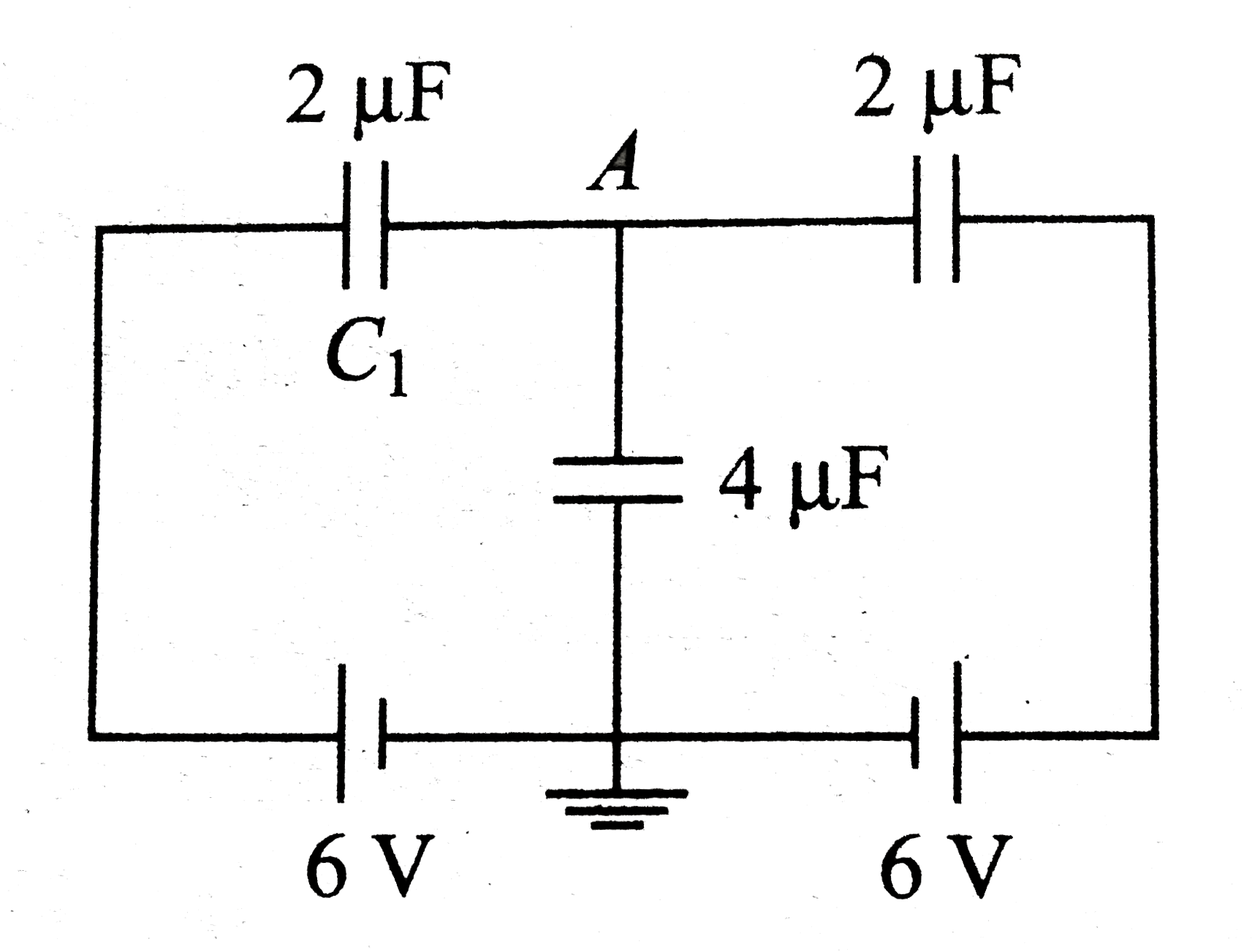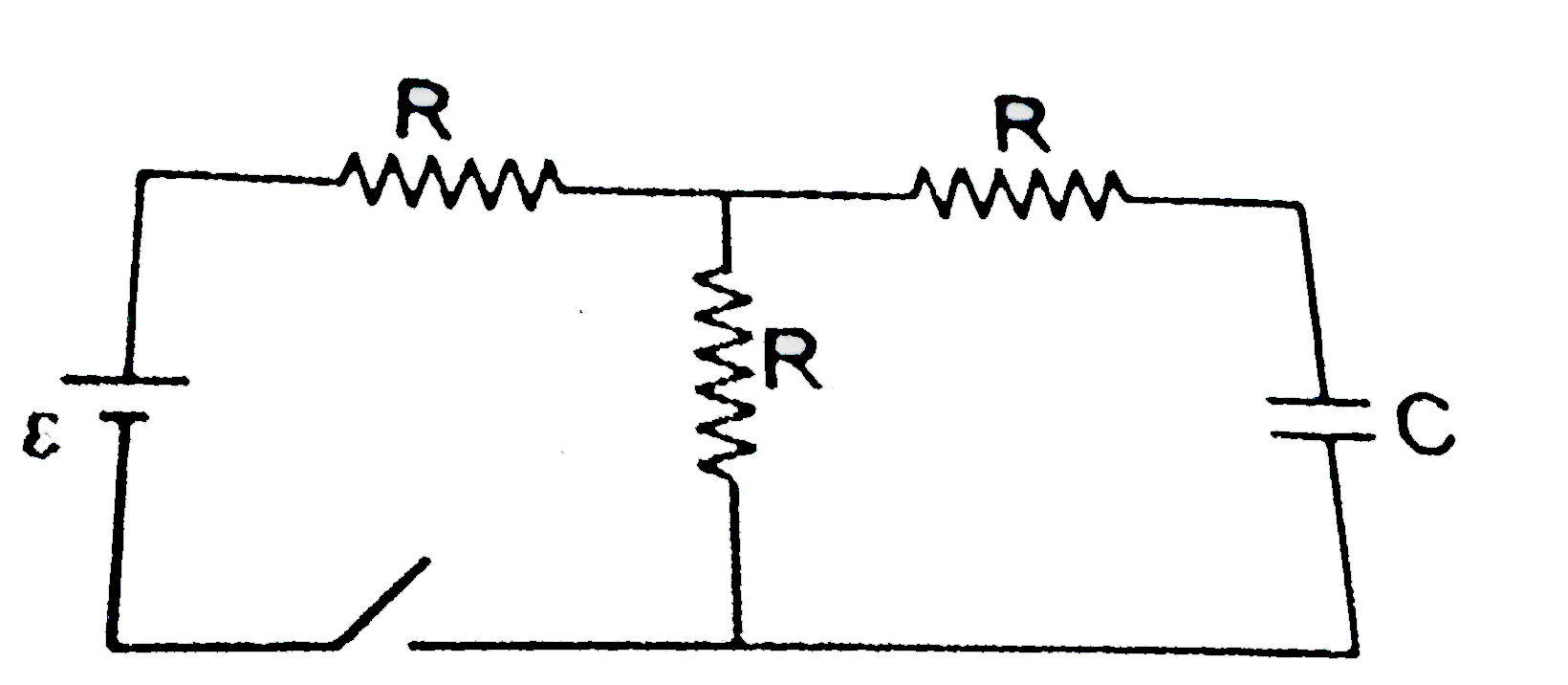When a charged capacitor is connected with an uncharged capacitor , then which of the following is /are correct option/options.
the magnitude of charge on the charged capacitor decreases.
a steady state is obtained after which no further flow of charge occurs.
the total potential energy stored in the capacitors remains conserved.
the charge conservation is always true.
The correct Answer is:A, B, D
To solve the question regarding the behavior of a charged capacitor when connected to an uncharged capacitor, let's break down the process step by step.
1. Understanding Capacitors:
- A capacitor stores electrical energy in the form of an electric field. When charged, it has a certain amount of charge (Q) and a potential difference (V) across its plates.
2. Connecting Capacitors:
- When a charged capacitor (let's call it Capacitor 1) is connected to an uncharged capacitor (Capacitor 2), charge will flow from Capacitor 1 to Capacitor 2 until the potential difference across both capacitors is equal.
3. Charge Flow:
- The charged capacitor (Capacitor 1) has a potential difference across its plates. When connected to the uncharged capacitor (Capacitor 2), charge will flow from the positively charged plate of Capacitor 1 to the uncharged plate of Capacitor 2 until the voltage across both capacitors equalizes.
4. Change in Charge:
- As charge flows from Capacitor 1 to Capacitor 2, the magnitude of charge on Capacitor 1 decreases. This is because some of its charge is now stored in Capacitor 2.
5. Steady State:
- A steady state is reached when the potential difference across both capacitors is the same. At this point, no further flow of charge occurs.
6. Total Energy Consideration:
- The total potential energy stored in the system remains conserved. While energy may redistribute between the two capacitors, the total energy before and after the connection remains the same, assuming ideal conditions (no losses).
7. Conservation of Charge:
- The principle of conservation of charge states that the total charge in an isolated system remains constant. Therefore, the total charge before and after the connection remains the same.
Conclusion:
Based on the above analysis, we can conclude that:
- The magnitude of charge on the charged capacitor decreases (Correct).
- A steady state is obtained after which no further flow of charge occurs (Correct).
- The total potential energy stored in the capacitors remains conserved (Correct).
- The conservation of charge is always true (Correct).
Thus, all options (A, B, C, D) are correct.
- A capacitor stores electrical energy in the form of an electric field. When charged, it has a certain amount of charge (Q) and a potential difference (V) across its plates.
- When a charged capacitor (let's call it Capacitor 1) is connected to an uncharged capacitor (Capacitor 2), charge will flow from Capacitor 1 to Capacitor 2 until the potential difference across both capacitors is equal.
- The charged capacitor (Capacitor 1) has a potential difference across its plates. When connected to the uncharged capacitor (Capacitor 2), charge will flow from the positively charged plate of Capacitor 1 to the uncharged plate of Capacitor 2 until the voltage across both capacitors equalizes.
- As charge flows from Capacitor 1 to Capacitor 2, the magnitude of charge on Capacitor 1 decreases. This is because some of its charge is now stored in Capacitor 2.
- A steady state is reached when the potential difference across both capacitors is the same. At this point, no further flow of charge occurs.
- The total potential energy stored in the system remains conserved. While energy may redistribute between the two capacitors, the total energy before and after the connection remains the same, assuming ideal conditions (no losses).
- The principle of conservation of charge states that the total charge in an isolated system remains constant. Therefore, the total charge before and after the connection remains the same.
Based on the above analysis, we can conclude that:
- The magnitude of charge on the charged capacitor decreases (Correct).
- A steady state is obtained after which no further flow of charge occurs (Correct).
- The total potential energy stored in the capacitors remains conserved (Correct).
- The conservation of charge is always true (Correct).
Topper's Solved these Questions
- CAPACITANCEBOOK - RESONANCE ENGLISHCHAPTER - CAPACITANCEEXERCISE - Exercise - 3
26 Videos
- CAPACITANCEBOOK - RESONANCE ENGLISHCHAPTER - CAPACITANCEEXERCISE - High Level Problems
16 Videos
- CAPACITANCEBOOK - RESONANCE ENGLISHCHAPTER - CAPACITANCEEXERCISE - Exercise - 1
79 Videos
- ATOMIC PHYSICSBOOK - RESONANCE ENGLISHCHAPTER - ATOMIC PHYSICSEXERCISE - Advanved level problems
17 Videos
- COMMUNICATION SYSTEMSBOOK - RESONANCE ENGLISHCHAPTER - COMMUNICATION SYSTEMSEXERCISE - Exercise 3
13 Videos
Similar Questions
A capacitor of capacitance C is charged to a potential differece V0. The terminals of the charged capacitor are then connected to those of an uncharged capacitor of capacitance C/2.
a. Compute the original charge of the system.
b. Find the final potential differce across each capacitor.
c. Find the final energy of the system.
d. Calculate the decrease in energy when the capacitors are connected.
e. Where did the ''lost'' energy go?
View SolutionA battery of 10V is connected to a capacitor of capacity 0.lF. The battery is now removed and this capacitor is connected to a second uncharged capacitor. If the charges are distributed equally on these two capacitors, find the total energy stored in the two capacitors. Find the ratio of final energy to initial energy stored in capacitors.
View Solution
Knowledge Check
Four capacitors and a battery are connected as shown in. If the potential difference aross the 7μF capacitor is 6V, then which of the following statement(s) is//are correct?
 AThe potential drop across the 12μF capacitor is 10 V.BThe charge on the 3μF capacitor is 42μC.CThe potential drop across the 3μF capacitor is 10V.DThe emf of the battery is 30 V.
AThe potential drop across the 12μF capacitor is 10 V.BThe charge on the 3μF capacitor is 42μC.CThe potential drop across the 3μF capacitor is 10V.DThe emf of the battery is 30 V.
Three capacitors are connected as shwn in. Then, the charge on capacitor C1 is .
 .
.
View SolutionA parallel plate capacitor with air as dielectric is charged to a potential .v. using a battery . Removing the battery. The charged capacitor is then connected across an identical uncharged parallel plate capacitor filled with was of dielectric constant k. The common potential of both the capacitor is
View SolutionIf the two plates of the charged capacitor are connected by a wire, then
View SolutionInitially the capacitor is uncharged find the charge on capacitor as a function of time, if switch is closed at t=0.

View SolutionThree uncharged capacitors are connected across a battery as shown. It is known that the energy stored in all the capacitors is same. Which of the following is not correct?

View SolutionA 8uF capacitor C1 is charged to V0=120V. The charging battery is then removed and the capacitor is connected in parallel to an uncharged +4μF capacitor C2.

(a) what is the potential difference V across the combination?
(b) what is the stored energy before and after the switch S is closed?
View SolutionFour capacitors and a battery are connected as shown in. If the potential difference aross the 7μF capacitor is 6V, then which of the following statement(s) is//are correct?

View Solution
